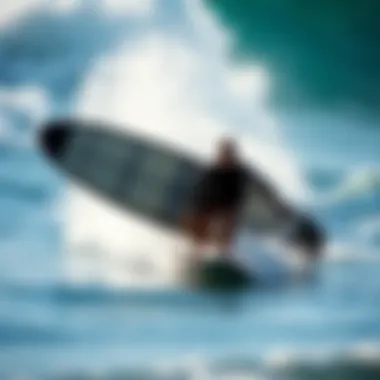Understanding Price Trends in Foil Surfing Gear


Intro
Foil surfing has taken the water sports world by storm, and with it, the demand for specialized equipment has surged. As any kiteboarder knows, the proper gear is not just an accessory; it’s the difference between soaring through the waves or floundering in the shallows. This article delves into the intricate pricing dynamics of foil surfing equipment, a vital aspect for enthusiasts—whether they're just starting out or are seasoned pros.
Understanding the costs associated with foil surfboards and their components is crucial. Prices can vary dramatically based on numerous factors: the materials used, brand reputation, innovation in design, and, of course, market trends. By grasping these elements, surfers can tailor their purchases to meet their performance needs without overspending. It’s a bit like a dance—knowing when to invest, when to wait, and when to jump on a good deal can make all the difference.
As we navigate through this guide, expect to dive deep into consumer preferences and the trends shaping the market. From beginner equipment to sophisticated tools for experts, we will break down what influences prices and how you can make the best choice for your surfing journey. Whether you’re looking for advice on what gear will enhance your experience or simply want to stay informed about pricing trends, this article has you covered.
Foreword to Foil Surfing
Foil surfing has become a prominent niche within the water sports community. While it might have started as a relatively obscure hobby, this activity has gained traction over the years, appealing to a wide range of enthusiasts and professionals alike. Understanding foil surfing is crucial not only for those looking to participate but also for those considering investing in the necessary equipment. This section serves to ground readers in the fundamentals of foil surfing, setting the stage for a detailed exploration of the subsequent elements regarding pricing and market dynamics.
Defining Foil Surfing
Foil surfing consists of riding on a surfboard equipped with a hydrofoil, which protrudes beneath the water’s surface. This unique setup allows the rider to glide above the water, minimizing drag and maximizing speed. The feeling of soaring above the waves is often likened to flying, providing a unique thrill that differentiates it from traditional surfing or windsurfing. In essence, foil surfing combines elements of various water sports, offering an innovative twist that challenges even the most seasoned surfers.
Evolution of Foil Surfing
The origins of foil surfing can be traced back to the early 20th century, but it wasn’t until the advances in hydrofoil technology that the sport gained significant popularity. In the early days, surfers experimented with makeshift designs, trying to find the sweet spot for stability and performance. As the years progressed, manufacturers began to refine these designs using materials like carbon fiber and other lightweight composites.
The shift towards mainstream acceptance began in the 2000s, when brands like Slingshot and Naish started producing commercial foil boards. They revolutionized the sport by making it accessible to a broader audience. The evolution didn’t stop there; innovations in design and technology have continually influenced the way foil boards are constructed, ultimately impacting their price points. Today, diverse options cater to various skill levels, with each iteration promising improved performance, durability, and user experience.
The journey of foil surfing mirrors that of many other sports, where technological advancements both challenge participants and elevate their experience. As this niche continues to grow, understanding its evolution allows potential buyers to appreciate the intricacies that contribute to the pricing of foil surfing equipment.
Understanding Foil Surf Equipment
When discussing foil surfing, it’s crucial to grasp the equipment involved. Understanding foil surf equipment not only helps enthusiasts make knowledgeable decisions but also enhances their overall experience on the water. Here, we’re digging deep into the integral components of foil surf boards, the materials that make them, and the various brands that populate the market.
Components of Foil Surf Boards
A foil surf board is more than just a plank of foam; it’s a finely tuned instrument. Generally, a complete foil surf board consists of several key parts:
- The Board: The core of any foil surfing setup, boards vary widely in size and shape, affecting the overall performance. Specific designs cater to different styles of surfing and can influence buoyancy and control.
- The Foil: This is essentially the underwater wing, which operates on the principle of lift. It's composed of a mast, wings, and a fuselage that connects everything. The size and shape of the foil’s wings play a significant role in its lift characteristics and stability during rides.
- Straps and Fins: These are for additional control. Straps keep the rider's feet secured to the board while fins can impact maneuverability and turning ease.
When combined correctly, these components create a synergy that enhances performance.
Materials Used in Foil Boards
The materials used to construct foil boards are critical for performance and durability. Here are some common materials:
- Expanded Polystyrene (EPS): A lightweight material often used for creating the core of the board. It offers excellent buoyancy but requires a protective outer layer for durability.
- Epoxy Resins: These resins are typically used to finish the boards, providing a tough shell that can withstand scratches and dings while maintaining a lower weight compared to traditional polyester resins.
- Carbon Fiber: An increasingly popular material for premium boards, carbon fiber is exceptionally strong and lightweight. It allows for better responsiveness, making it a favorite among serious surfers.
Each material presents its own cost implications, affecting the price range of the boards on the market. Paying attention to these details can significantly impact performance and overall enjoyment while surfing.
Brands and Their Offerings
In the realm of foil surfing, several brands stand out, each presenting unique features and caters to various skill levels. Some notable names include:
- Naish: Known for their innovative designs, Naish foils often come with comprehensive kits, making them a popular choice for both beginners and advanced surfers.
- Slingshot: A brand beloved for its quality and performance, Slingshot offers a range of products from entry-level to high-performance foils.
- Lift Foils: Focused on electric hydrofoils, Lift is leading the charge in new technology that allows surfers to ride without the need for waves.


These brands constantly evolve, incorporating feedback from the surfing community to improve their offerings. Understanding brand positioning and reputation is key to making an informed decision when selecting equipment that matches one's abilities and ambitions.
Foil Surf Price Factors
Understanding the pricing dynamics of foil surfing equipment is essential for any enthusiast in the water sports community. Several interconnected elements play significant roles in determining the costs associated with foil boards and related gear. This section will delve into three key factors: material costs, innovation and technology, and brand reputation. By breaking down these aspects, surfers can gain clearer insights into why certain products bear higher price tags and what value they bring to the table.
Material Costs
The choice of materials used in foil surf boards greatly impacts their pricing. For instance, boards made from high-density foam coupled with carbon fiber tend to come with a steeper price tag compared to those constructed from standard fiberglass. This is primarily due to the lightweight nature and increased durability that premium materials provide. With lighter boards, surfers experience improved speed and maneuverability. However, while a surfer might be tempted to opt for a budget-friendly version, it’s worth considering the long-term performance and potential repeated costs that cheaper materials might incur over time.
Moreover, material costs can fluctuate based on global supply and demand trends. For example, as sustainability becomes more significant to consumers, the cost of eco-friendly materials is rising. This consumer trend is interesting because it shows how the values and preferences of surfers can shape the market.
"Investing in quality materials isn’t just a purchase; it’s a long-term commitment to performance and enjoyment on the water."
Innovation and Technology
The surfing equipment industry is never stagnant; innovation is a crucial driver for pricing. Many companies are constantly experimenting with new designs and technologies, such as enhanced hydrodynamics, which can significantly improve speed and control. A prime example includes foils that feature advanced wing designs or adjustable mounts that allow customization for different skill levels.
While these technological advancements often come with elevated costs, they also bring enhancements that can drastically improve a surfer's experience. The investment in cutting-edge technology serves an essential need for both competitive athletes and casual riders. Thus, consumers who are after the latest in performance upgrades may find themselves paying a premium, yet unwittingly, these purchases could lead to greater satisfaction and results on the water.
Brand Reputation
When it comes to foil surfing gear, brand reputation plays an influential role in pricing. Established brands like Naish or A2 Foil Systems have spent years building their names based on quality and reliability. Their established reputations allow them to price their products at a premium compared to lesser-known brands. Consumers often associate these well-regarded brands with guaranteed performance and support, making them a go-to choice for serious surfers.
However, it’s important for buyers to strike a balance; the presence of an eminent brand shouldn’t overshadow the need for individual preference and necessity. Sometimes, newer or lesser-known brands offer excellent value without the hefty price tags, but it requires careful research.
Market Trends in Foil Surfing Equipment
Understanding the market trends in foil surfing equipment is crucial for enthusiasts and professionals alike. This section sheds light on various elements that shape pricing dynamics, ultimately aiding consumers in making well-informed decisions tailored to their needs. Various factors such as technological advancements, consumer preferences, and economic conditions influence these trends. Not only do these factors determine the initial cost, but they also guide long-term investment strategies for both beginners and seasoned surfers.
Current Pricing Trends
When one takes a snipe at current pricing trends for foil surfing equipment, several themes emerge that demand attention. First off, the blend of materials and the technology incorporated play a substantial role in the cost. The use of lightweight composites, advanced foils, and superior craftsmanship can push prices higher, yet these features often translate into enhanced performance.
For instance, the shift towards eco-friendly materials is becoming more common. Brands that adopt these practices usually see their prices rise but also tap into a more environmentally conscious consumer base. Moreover, with growing competition in the market, brands are often forced to adjust prices to stay attractive.
Recent reports indicate that entry-level models generally range from $800 to $1,500. In contrast, more performance-oriented models often exceed $2,500, reflecting their advanced features. This trend illustrates how technology not only affects performance but is also a significant player in price stratification.
Regional Price Variations
Regional factors also come into play when discussing price variations in foil surfing equipment. Markets are not monolithic; they largely depend on availability, local demand, and supply chains. In regions with a thriving surf culture, prices tend to be lower due to competition and more options available. Conversely, in areas where foil surfing is still a niche, pricing can soar.
For example, in coastal locations like California or Hawaii, where foil surfing has gained enthusiastic traction, local shops often drive prices down through variety and competition. In contrast, states or regions where water sports are less prominent might see limited options and higher prices due to transportation costs and import fees.
Additionally, global events, such as tariffs or changes in import regulations, can also influence the pricing landscape. Seasonality plays a role too; demand rises during peak surf seasons, leading to potential price hikes.
The amalgamation of these regional variances creates a complex tapestry, affecting how pricing trends emerge in different locales. Here, savvy buyers need to be aware of these local nuances, as variations can be staggering depending on where one is shopping.
"Understanding where you buy your foil surfing gear may be just as important as knowing what to buy."
Ultimately, navigating the landscape of market trends requires attention to both current pricing and regional variations. Knowledge of these aspects ensures a more informed purchase, tailored to individual performance goals or budget constraints. As foil surfing continues to evolve, staying abreast of these trends will empower consumers to make decisions that align with their preferences.


Consumer Behavior and Preferences
Understanding how consumers interact with foil surfing equipment not only sheds light on their purchasing habits but also highlights the underlying trends that drive those decisions. Grasping consumer behavior in this niche market is vital in unpacking why certain price points resonate with buyers and how perceived value correlates with actual performance. When enthusiasts set out to purchase foil gear, they consider multiple dimensions that influence their choices, like skill level, functionality needs, brand loyalty, and budget constraints. This analysis doesn’t merely serve commercial interests; it points to an interconnected web of desires, experiences, and aspirations that every foil surfing enthusiast fulfills through their gear.
Choosing Based on Skill Level
When it comes to selecting foil equipment, skill level is paramount for both safety and enjoyment. Novice surfers tend to lean towards more forgiving setups. Boards that offer stability and ease of use, coupled with flexible foils, tend to attract beginners who might feel overwhelmed by intricate gear. In contrast, seasoned riders often search for equipment that provides a higher performance ceiling, sacrificing some ease for speed and agility.
- Newbies: A learner may gravitate towards an entry-level board from brands like Slingshot or Naish while seeking to minimize costs without sacrificing quality. They need a setup that balances support and maneuverability.
- Intermediate Riders: As surfers progress, they often shift towards models that enhance their abilities, maybe exploring options from suppliers like JP Australia as they understand more about their personal riding style.
- Professionals: Advanced surfers go for finely-tuned equipment, often crafted from specialized materials that can withstand extreme conditions. High-end brands such as Fanatic cater to this market segment with gear designed for performance and competitive setups.
Budget Considerations
When it comes to budget considerations, patience pays off. Not every enthusiast can drop several thousand dollars on high-performance gear right off the bat. Buyers often juggle their flexibility with financial limitations while keeping an eye out for sales or second-hand equipment. A few factors shape the economics of buying foil gear:
- Entry-Level Pricing: First-time buyers might find offerings in the $800 range from brands like Litewave. These boards tend to be less costly yet durable enough for travelers or casual riders.
- Mid-Range Value: After initial refinement and experience, customers often invest in boards in the $1200-$2000 range, as brands like Tau can provide the fine-tuning and technological integration needed for more complex maneuvers.
- Top-Tier Market: Professional or performance-oriented foils command higher prices, often upwards of $3000. Groups invested in top brands like Gofoil or Lift undersand that their investment is for cutting-edge technology and superior craftsmanship, increasing the longevity and reliability of their gear.
In summary, understanding consumer behavior and preferences within the dynamics of foil surfing equipment provides invaluable insight into how pricing structures are established. As skills improve, purchases made can reflect a deeper connection not only to the sport but also to the community surrounding it. Such preferences aren’t just about owning gear but embody the spirit of adventuring, fostering relationships with brands, and shaping the ever-evolving landscape of foil surfing.
"The right gear can make all the difference, turning the learning curve into a smooth glide over water."
For those pursuing deeper insights, resources like Wikipedia or forums on Reddit can provide diverse perspectives on the latest trends and equipment evaluations.
Performance Metrics and Their Influence on Price
When diving into the world of foil surfing, it’s essential to recognize that performance metrics play an integral role in the pricing landscape of foil surfing equipment. Factors like speed, agility, durability, and maintenance not only reflect a board's capabilities but also influence how much consumers are willing to pay. For instance, high-performance gear typically comes with a higher price tag because it promises better surfing experiences and more durability. Understanding these metrics allows buyers to make informed decisions that match their performance expectations and budget constraints.
Speed and Agility
Speed and agility are perhaps the most discussed performance metrics in the context of foil surfing. The ability of a board to cut through water efficiently and respond quickly to the surfer's commands can make a huge difference in overall experience. A board equipped with advanced hydro-dynamic designs and a finely tuned foil can achieve remarkable speeds. This means less energy wasted paddling and more time riding the waves.
The materials used in speed-focused designs also contribute to their pricing. Carbon fiber, for instance, provides a lightweight structure that enhances speed but comes at a premium cost. On the other hand, boards made from heavier materials might be more affordable but won’t offer the same performance upgrades.
Moreover, agility influences how well a board can maneuver during turns and tricks. Riders often pay a little extra for:
- Enhanced responsiveness
- Reduced drag
- Improved handling in waves
Ultimately, if a surfer prioritizes speed and agility in their sessions, they are likely willing to shell out a fair bit more for equipment boasting these metrics.
Durability and Maintenance
Durability is another crucial aspect influencing price. Boards that can stand the test of time, take on rough waves, and resist wear and tear due to saltwater exposure don’t just offer long-term value—they also tend to command a higher price. When a brand uses high-quality materials and superior construction methods, it enhances the lifespan of the product.
Maintenance becomes intertwined with durability. If a board is prone to dings or requires constant repairs, the total cost of ownership skyrockets. Buyers typically prefer to invest in products that won’t need frequent upkeep.
Some important considerations regarding durability are:
- Material Strength: Boards made with tougher materials can endure harsher conditions.
- Warranty and Service: An extended warranty can offer peace of mind and is often a marker of a brand’s confidence in its durability claims.
- Maintenance Needs: Less frequent maintenance can save money in the long run, justifying a larger initial investment.
In summary, the performance metrics of speed, agility, durability, and maintenance factor deeply into the pricing structure of foil surfing equipment. Enthusiasts are often faced with the decision to balance these metrics against their budget, an understanding that leads them towards making choices best suited to their preferences and surfing styles.
Comparative Analysis of Price Ranges


Understanding the pricing spectrum of foil surfing equipment is crucial for enthusiasts, whether they're just getting their feet wet or are seasoned pros. This comparative analysis is not just a stroll down the beach—it’s a vital tool for making sound purchasing decisions. When you unravel the price ranges, you uncover the differences in quality, technology, and design that can greatly impact performance. Equipping yourself with this knowledge allows you to match your skill level and budget with the right equipment, ensuring a satisfying surfing experience.
Entry-Level Options
For those just beginning their journey into foil surfing, entry-level options serve as a window into this exciting sport without causing turmoil in your wallet. These boards often feature simpler designs and materials, which make them more affordable. Typically, entry-level foils are crafted from durable, yet less expensive materials, making them suitable for beginners who might take a few tumbles in the learning phase.
- Price Range: Generally from $800 to $1,200.
- Key Features:
- Basic construction with foam and fiberglass materials.
- More forgiving shapes, which are easier to ride.
- Suitable for flat water and mild conditions.
Purchasing a starter kit at this price point means you can get your feet wet (so to speak) without breaking the bank. It’s essential to note that while skimping on price may save dollars, it’s also critical to avoid models that compromise on safety and durability. Ideally, opt for brands that have established a reputation for producing reliable entry-level products.
Mid-Range Choices
As surfers progress and their skills sharpen, mid-range choices become appealing. These boards offer a balance between price and performance, a sort of sweet spot where you get additional features for your money without climbing the heights of high-end models.
- Price Range: Generally from $1,200 to $2,000.
- Key Features:
- Enhanced materials like carbon fiber and lightweight foils.
- More refined shapes for better aerodynamics.
- Ability to handle a variety of conditions, including waves.
Investing in a mid-range setup not only boosts your performance but also contributes to longer durability. The brands in this range often provide better customer service and warranties, which can be invaluable when you're starting to push your limits on the water.
High-End Investments
High-end investments in foil surfing equipment are for those who are serious about the sport and ready to shell out some serious cash. These products represent the pinnacle of technology, design, and performance. They cater to competitive surfers or anyone who wants the best of the best.
- Price Range: Starts from $2,000 and can go beyond $3,500.
- Key Features:
- State-of-the-art materials that minimize weight while enhancing strength.
- Advanced technology such as adjustable foils and interchangeable wings.
- Superior performance capabilities in all conditions, from calm waters to heavy surf.
Though these boards come at a steep price, they often provide measurable returns in terms of speed, skill enhancement, and overall experience. Furthermore, high-end brands often actively invest in continuous innovation, ensuring that you receive the latest technology in your gear.
"The most important investment in foil surfing isn’t just financial; it’s also about understanding your personal needs and ambitions on the water."
Final Thoughts on Foil Surf Pricing
In the ever-evolving realm of foil surfing, understanding how price dynamics function is not merely an academic exercise; it holds real-world implications for both novice and seasoned surfers. The price of foil surfing equipment is shaped by a multitude of factors, each interlinking to create a landscape that reflects consumer demand, material enhancements, and technological advancements. These intricacies inform purchasing decisions and ultimately determine satisfaction on the water.
Making Informed Decisions
When contemplating the purchase of foil surfing gear, the importance of making informed decisions cannot be overstated. As costs can range significantly—from an affordable entry-level option to high-end models that push the limits of technology—buyers must assess their needs carefully.
- Understand Your Skill Level: If you're recently bitten by the foil surfing bug, investing heavily in advanced gear may not be justified. Conversely, experienced surfers might find that embracing higher price points brings benefits in performance and durability.
- Evaluate Brands and Their Offerings: Familiarizing oneself with various brands can be enlightening. Not all manufacturers offer the same quality or value proposition. For example, brands like Slingshot and Naish are renowned for innovation, while others might excel in affordability without compromising too much on performance.
- Consider Materials and Technology: The components used in the boards and foils—like carbon fiber or aluminum—speak volumes about durability and overall performance. Higher-quality materials often come with price hikes, but they also promise longer lifespans and enhanced riding experiences.
Ultimately, cultivating an informed viewpoint allows for prioritizing features that align closely with individual riding styles and preferences, aiding in wiser purchasing moves that won’t break the bank.
Future Trends to Watch
As we look to the horizon, several trends in foil surfing equipment pricing deserve attention, reflecting the dynamic fusion of technology and consumer preferences.
- Sustainable Materials: The push for eco-friendly production methods is gaining traction. Expect to see an uptick in options utilizing recycled materials, which might make for a more sustainable and potentially lower-cost-to-market offering in the long run.
- Technological Innovation: The advent of smarter gear integrated with digital sensors is on the rise. These innovations could extend product lifespans and improve performance metrics. As technology advances, prices may stabilize in the face of increased production efficiency.
- Customization Options: More brands are moving toward providing personalized equipment that could cater to individual preferences—think adjustable foils or tailored board shapes. While this may introduce a higher initial price, such customization could enhance user experience, potentially justifying the cost.
- Market Expansion: As foil surfing captures the interest of a broader community, increased competition might filter down into pricing. More accessible entry points could emerge, motivating existing brands to rethink their pricing strategies to retain market share.
As these trends evolve, they will shape not only what consumers see on the shelves but also how effectively they can allocate budget for their foil surfing passions.
"An informed decision is only as good as the information that underpins it. With fast-moving trends and intricate pricing structures, staying educated is key to maximizing your foil surfing experience."
In closing, a multifaceted understanding of foil surfing price dynamics arms consumers with the insight needed to make educated choices, allowing them to navigate the waves armed with the right gear—no matter their skill level.















